当前位置:网站首页>Data communication foundation - Ethernet port mirroring and link aggregation
Data communication foundation - Ethernet port mirroring and link aggregation
2022-07-05 15:35:00 【GALi_ two hundred and thirty-three】
Port Mirror
- In some scenes , We need to monitor the inbound or outbound messages of the specific port of the switch .
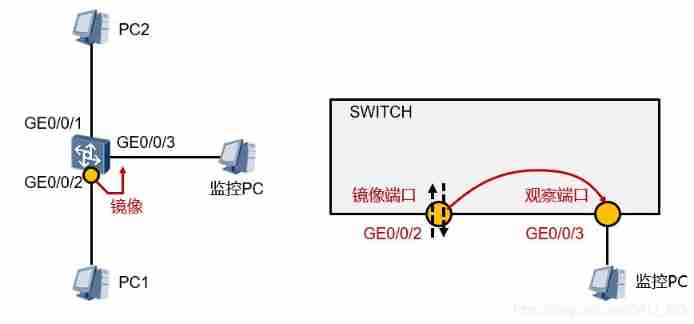
summary
Application of image :
Flow observation
Fault location
Classification of images :
Port based mirroring
Port mirroring will be Monitor the data on the port Copy to the specified monitoring port , Analyze and monitor data .Stream based mirroring
Stream mirroring is to Business flow matching access control list rules Copy to the specified monitoring port , Used for message analysis and monitoring .
Port based mirroring
- Port mirroring means that the switch copies a message flowing through the mirrored port ( You can specify inbound or outbound ), And send this message to the designated observation port for analysis and monitoring . Port mirroring , All messages flowing through the image port will be copied to the observation port .
- Ethernet switches support many to one mirroring , Copy messages from multiple ports to one monitoring port .
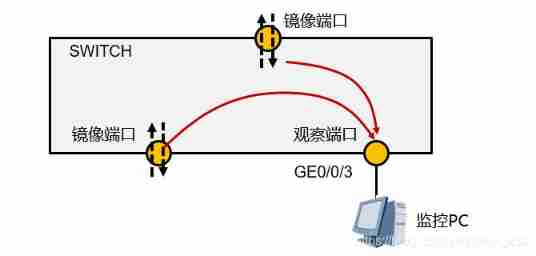
- Port mirroring is divided into local port mirror and remote port image
Local port mirroring and remote port mirroring
Local port mirroring :
In the local port image , The monitoring host is directly connected to the observation port .
Remote port mirroring :
Remote port image , The monitoring host and the device where the observation port is located are connected through a two-layer network or a three-layer network .
Layer 2 Port mirroring (RSPAN:Remote Switched Port Analyzer): If it is interconnected through a two-layer network ,S9300 Encapsulate the message of the image port VLAN, Then, the message is remotely mirrored through the observation port VLAN Broadcast in . After the remote device receives the message , Compare the message VLAN ID, If the same , Then forward the message to the remote observation port .
Layer 3 port mirroring (ERSPAN:Encapsulated Remote SPAN): If it is interconnected through a three-layer network ,S9300 Use GRE Packet header encapsulation and de encapsulation of image message , So that the image message can penetrate the three-layer network , So as to realize the port mirroring when the device where the image port is located and the device where the observation port is located are connected through the three-layer network .
Stream based mirroring
- Stream mirroring is to copy the specific data on the stream mirroring port to the specified observation port or CPU Analysis and monitoring . A stream mirroring port is an interface that applies a stream policy that includes the stream mirroring behavior , Messages flowing through the stream image port , If the flow classification in the flow policy on this interface is matched , Will be copied and transferred to the observation port or CPU.
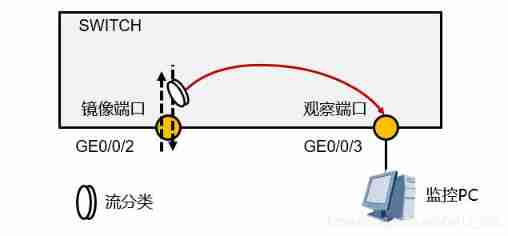
There are two types of stream mirroring , That is, the stream is mirrored to the interface and the stream is mirrored to CPU:
Stream mirrored to Interface , It is to copy a message that meets the requirements on the interface configured with stream image , Then it is sent to the observation port for analysis and diagnosis .
Stream mirrored to CPU, It is to copy a message that meets the requirements on the interface configured with stream image , Then send it to CPU For analysis and diagnosis . there CPU It refers to the interface on the interface board where the stream image is configured CPU.
Configure local port mirroring
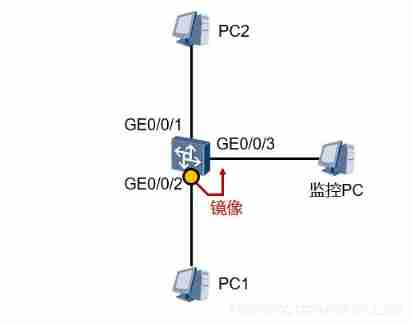
- Switch GE0/0/2 Port in 、 Export message is mirrored to GE0/0/3.
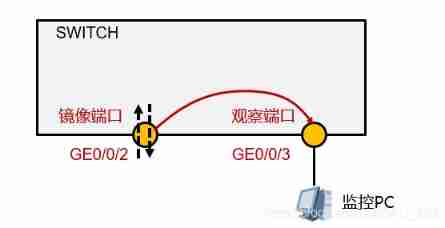
To configure :
[SW] observe-port 1 interface gigabitethernet0/0/3 # Configure the monitoring port as the observation port
[SW] interfae gigabitethernet0/0/2
[SW-gigabitethernet0/0/2] port-mirroring to observe-port 1 both # Interface traffic is mirrored to the observation port
display observe-port # View the configuration information of the observation port
diaplay port-mirroring # View the configuration information of the mirroring function
both Is the mirror direction , It means that bidirectional data should be copied to the observation port , Besides, there are inbound and outbound.
Link aggregation
- Link aggregation (Link Aggregation) Yes, it will — Group physical interfaces are bundled together as a way to increase bandwidth as a logical interface , It is also called multi interface load balancing group (Load Sharing Group) Or link aggregation group (Link Aggregation Group), For relevant protocol standards, please refer to IEEE802.3ad.
- By establishing a link aggregation group between two devices , Can provide Higher communication bandwidth and Higher reliability . Link aggregation not only provides for communication between devices Redundancy protection , And there is no need to upgrade the hardware .
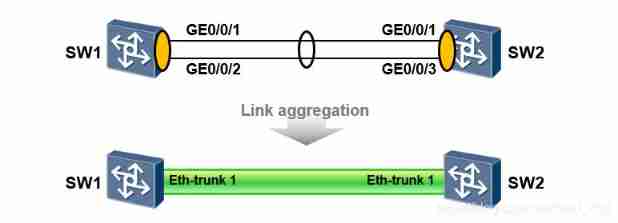
stay SW1 Admiral GE0/0/1 And GE0/0/2 Interface to aggregate , So as to form a logical interface Eth-trunk, SW2 Empathy . In this way ,SW1 And SW2 The link between them becomes a logical link . such , The bandwidth of the link is increased , Redundancy is also enhanced .
Huawei's network equipment supports two types Eth-trunk Working mode :
Manual load sharing mode
LACP Pattern
Manual load sharing
Manual load sharing (Manual load-balance) In mode ,Eth-Trunk The establishment of the 、 The member interface is added by Manual configuration , No, LACP(link Aggregation Control Protocol) Participation in protocol messages .
In this mode, all active links are involved in data forwarding , Average shared flow , Therefore, it is called load sharing mode .
If an active link fails , The link aggregation group automatically shares the traffic among the remaining active links .
When it is necessary to provide a large link bandwidth between two directly connected devices, and the device does not support LACP When the agreement , Manual load sharing mode can be used .
static state LACP
static state LACP(Static LACP) Pattern is a kind of utilization LACP The protocol performs aggregation parameter negotiation 、 Determine the link aggregation mode of active and inactive interfaces .
In this mode , It needs to be created manually Eth-Trunk, Hand in Eth-Trunk Member interface , from LACP Protocol negotiation determines active and inactive interfaces .
static state LACP Patterns are also called M∶N Pattern . In this way, the dual functions of link load sharing and link redundant backup can be realized at the same time . In the link aggregation group M Links are active , These links are responsible for forwarding data and load sharing , in addition N Links are inactive as backup links , Don't forward data . When M When one of the links fails , The system will N Select the link with the highest priority from the backup links to replace the failed link , At the same time, the backup link that replaces the failed link becomes active and starts forwarding data .
static state LACP The main difference between mode and manual load sharing mode is : static state LACP Mode has a backup link , In the manual load sharing mode, all member interfaces are in forwarding status , Share load traffic .
And static LACP Patterns also correspond to dynamic LACP Pattern . dynamic LACP Link aggregation mode , from Eth-Trunk There is no need for human intervention from the creation of the member interface to the joining of the member interface , from LACP Automatic agreement negotiation is completed . Although this method is very simple for users , But because this method is too flexible , Not easy to manage , therefore S9300 Dynamic... Is not supported on LACP Mode link aggregation .
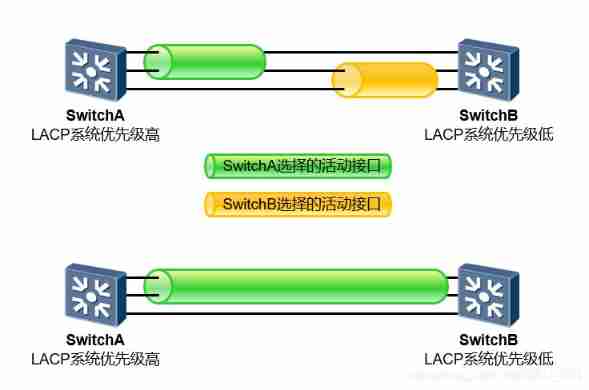
LACP Pattern ( Add )
LACP: be based on IEEE802.3ad The standard LACP( Link aggregation control protocol ) It is a protocol to realize dynamic link aggregation .LACP Agreement passed LACPDU( Link aggregation control protocol data unit ) Interact with the opposite end . Enable... For a port LACP After the agreement , The port will send through LACPDU Announce your system priority to the opposite end 、 System MAC Address 、 Port priority 、 Port number and operation Key. After receiving the information from the opposite end , Compare this information with the information saved by other ports to select the ports that can be converged , In this way, both parties can reach an agreement on whether to join or exit a dynamic aggregation group .
System LACP priority
System LACP Priority is a parameter configured to distinguish the priority of devices at both ends .LACP In mode , The active interfaces selected by devices at both ends must be consistent , Otherwise, the link aggregation group cannot be established . At this point, one end can have a higher priority , The other end selects the active interface according to the high priority end . System LACP The smaller the priority value, the higher the priority .
Interface LACP priority
Interface LACP Priority is to distinguish the same Eth-Trunk The different interfaces in are selected as the priority of the active interface , The interface with higher priority will be selected as the active interface first . Interface LACP The lower the priority value , The higher the priority .
Between member interfaces M:N Backup
LACP Mode link aggregation consists of LACP Determine the active and inactive links in the aggregation group , Also known as M:N Pattern , namely M Active link and N Mode of backup link . This mode provides higher link reliability , And you can M Different ways of load balancing are realized in each link .
There are... Between the two equipment M+N Links , When forwarding traffic on an aggregated link, the traffic is transmitted at M The load is shared on the chain , Active link , Not in another N Link forwarding traffic , this N Links provide backup functions , Backup link . At this time, the actual bandwidth of the link is M The sum of links , But the maximum bandwidth that can be provided is M+N The sum of links .
When M When one of the links fails ,LACP From N Find a high priority available link among the backup links to replace the failed link . At this time, the actual bandwidth of the link is still M The sum of links , But the maximum bandwidth available becomes M+N-1 The sum of links .
M:N Backup diagram

This scenario is mainly used to provide users with M Bandwidth of links , At the same time, it is hoped to provide certain fault protection capability . When a link fails , The system can automatically select an available backup link with the highest priority to become an active link .
If an available link cannot be found in the backup link , And the number of currently active links is lower than the configured lower threshold of the number of active interfaces , Then the system will close the aggregation interface .
LACP preemption :
- LACP Preemption is not enabled , After an interface failure that was originally an active interface , Recovery will act as a backup interface ;
- LACP Preemption enable , After an interface failure that was originally an active interface , The resumption will renegotiate , As an active interface .
Specific configuration
Manual load sharing mode link aggregation
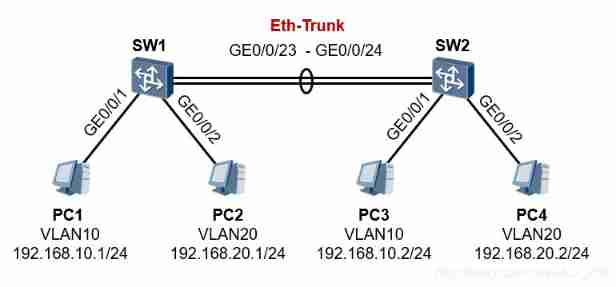
Divide vlan And enter the interface
SW1 To configure
[SW1]vlan batch 10 20
[SW1]interface GigabitEthernet 0/0/1
[SW1-GigabitEthernet0/0/1]port link-type access
[SW1-GigabitEthernet0/0/1]port default vlan 10
[SW1]interface GigabitEthernet 0/0/2
[SW1-GigabitEthernet0/0/2]port link-type access
[SW1-GigabitEthernet0/0/2]port default vlan 20
SW2 To configure
[SW2]vlan batch 10 20
[SW2]interface GigabitEthernet 0/0/1
[SW2-GigabitEthernet0/0/1]port link-type access
[SW2-GigabitEthernet0/0/1]port default vlan 10
[SW2]interface GigabitEthernet 0/0/2
[SW2-GigabitEthernet0/0/2]port link-type access
[SW2-GigabitEthernet0/0/2]port default vlan 20
Create interfaces Eth-trunk1, And will GE0/0/23 And 24 Ports are added to the aggregation link
SW1:
[SW1]interface Eth-Trunk 1
[SW1-Eth-Trunk1]mode manual load-balance # The default is manual loading
[SW1-Eth-Trunk1]trunkport GigabitEthernet 0/0/23
[SW1-Eth-Trunk1]trunkport GigabitEthernet 0/0/24
# because Eth-trun1 The interface needs to carry more VLAN, Therefore, it needs to be configured as trunk Pattern :
[SW1-Eth-Trunk1]PORT link-type trunk
[SW1-Eth-Trunk1]PORT trunk allow-pass vlan 10 20
SW2:
[SW2]interface Eth-Trunk 1
[SW2-Eth-Trunk1]mode manual load-balance
[SW2-Eth-Trunk1]trunkport GigabitEthernet 0/0/23
[SW2-Eth-Trunk1]trunkport GigabitEthernet 0/0/24
[SW2-Eth-Trunk1]port link-type trunk
[SW2-Eth-Trunk1]port trunk allow-pass vlan 10 20
View interface information :

In manual load sharing mode , All interfaces are up
Add : After creating Eth-trunk After the interface , Member interface ( Physical interface ) Add to the Eth-trunk in , There are two configuration methods , These two configurations have the same effect :
[SW1]interface Eth-Trunk 1
[SW1-Eth-Trunk1]trunkport GigabitEthernet 0/0/23
[SW1-Eth-Trunk1]trunkport GigabitEthernet 0/0/24
perhaps
[SW1]interface Eth-Trunk 1
[SW1-Eth-Trunk1]quit
[SW1]interface GigabitEthernet 0/0/23
[SW1-GigabitEthernet0/0/23]eth-trunk 1
[SW1]interface GigabitEthernet 0/0/24
[SW1-GigabitEthernet0/0/24]eth-trunk 1
static state LACP Mode link aggregation
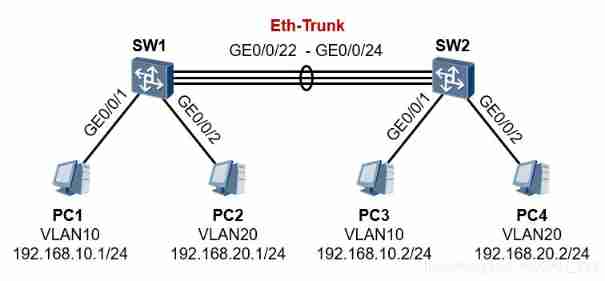
- SW1、SW2 Of GE0/0/22、23 And 24 Mouth to mouth , Bound into Eth-Trunk, Use static LACP Pattern , also 2 Links are active , The other one is the backup link .SW1 by LACP Active end .
SW1 To configure :
[SW1]interface Eth-Trunk 1
[SW1-Eth-Trunk1]mode lacp-static
[SW1-Eth-Trunk1]max active-linknumber 2 # Maximum number of active chain paths , Default is 8
[SW1-Eth-Trunk1]trunkport GigabitEthernet 0/0/22
[SW1-Eth-Trunk1]trunkport GigabitEthernet 0/0/23
[SW1-Eth-Trunk1]trunkport GigabitEthernet 0/0/24
[SW1]lacp priority 1 # The system of the equipment LACP The priority is set to 1
# System LACP The smaller the priority value, the higher the priority , Default is 32768.
SW2 To configure :
[SW2]interface Eth-Trunk 1
[SW2-Eth-Trunk1]mode lacp-static
[SW2-Eth-Trunk1]max active-linknumber 2
[SW2-Eth-Trunk1]trunkport GigabitEthernet 0/0/22
[SW2-Eth-Trunk1]trunkport GigabitEthernet 0/0/23
[SW2-Eth-Trunk1]trunkport GigabitEthernet 0/0/24
View interface information :
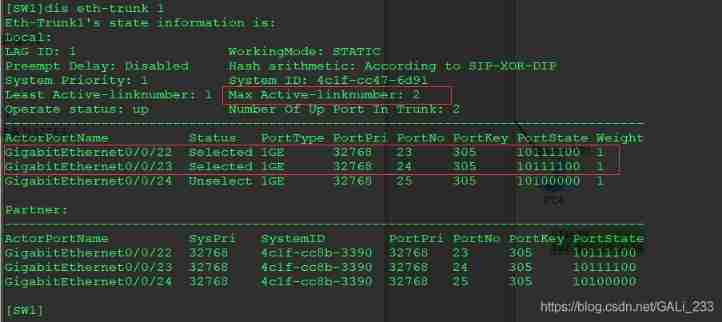
Turn off the SW2 Of G0/0/22 Interface
[SW2]interface GigabitEthernet 0/0/22
[SW2-GigabitEthernet0/0/22]shutdown
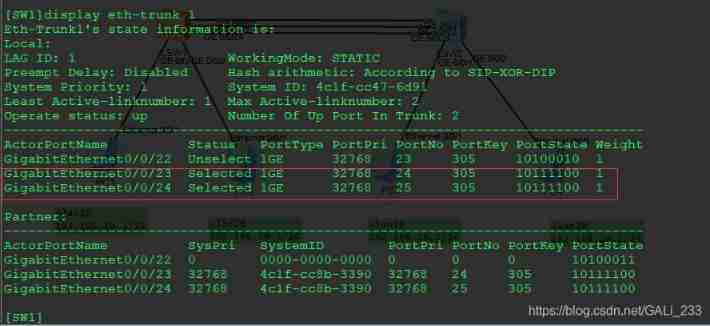
Backup interface to active interface
边栏推荐
- [recruitment position] Software Engineer (full stack) - public safety direction
- [brief notes] solve the problem of IDE golang code red and error reporting
- Bugku alert
- CODING DevSecOps 助力金融企业跑出数字加速度
- 数学建模之层次分析法(含MATLAB代码)
- Explanation report of the explosion
- qt creater断点调试程序详解
- keep-alive
- I spring and autumn blasting-2
- Misc Basic test method and knowledge points of CTF
猜你喜欢
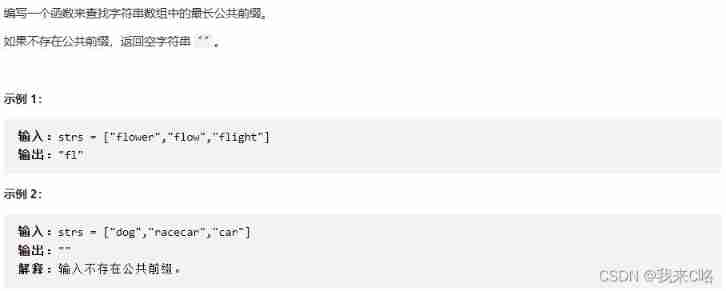
Optional parameters in the for loop

Detailed explanation of C language branch statements
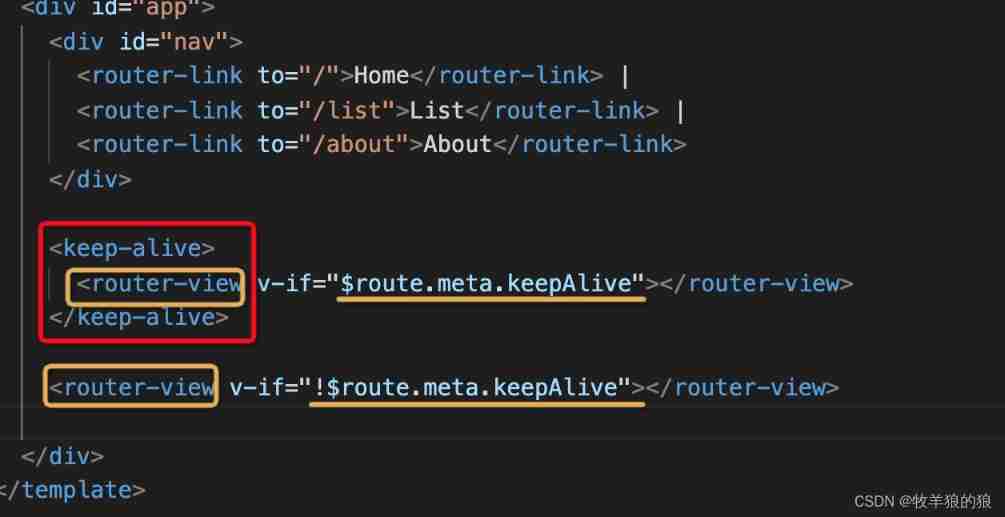
keep-alive
![P6183 [USACO10MAR] The Rock Game S](/img/f4/d8c8763c27385d759d117b515fbf0f.png)
P6183 [USACO10MAR] The Rock Game S

Codasip为RISC-V处理器系列增加Veridify安全启动功能

Bugku's Ah Da

B站做短视频,学抖音死,学YouTube生?
![[brief notes] solve the problem of IDE golang code red and error reporting](/img/b6/0b2ea06eb5fbe651ff9247b109fa15.png)
[brief notes] solve the problem of IDE golang code red and error reporting
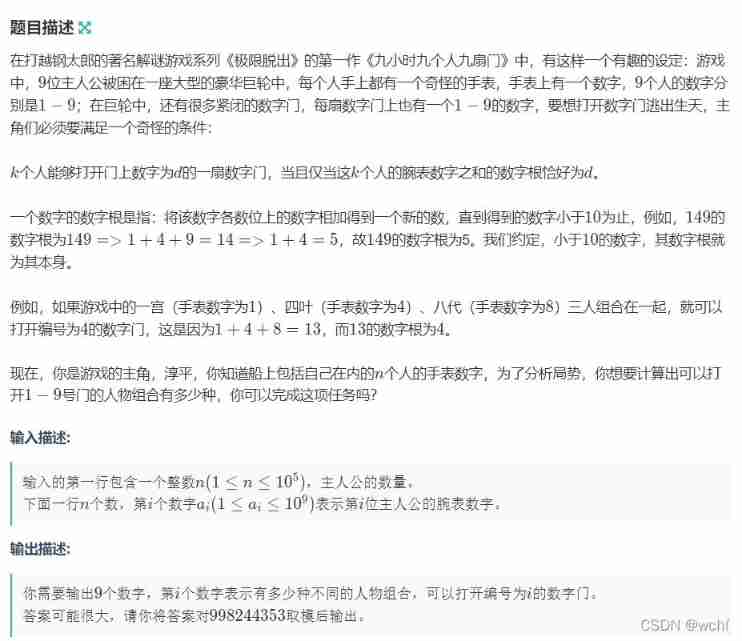
Nine hours, nine people, nine doors problem solving Report
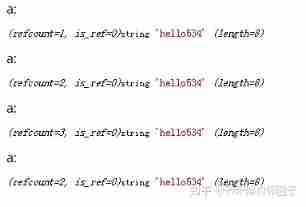
Garbage collection mechanism of PHP (theoretical questions of PHP interview)
随机推荐
I include of spring and Autumn
Ctfshow web entry explosion
Explanation report of the explosion
What are CSRF, XSS, SQL injection, DDoS attack and timing attack respectively and how to prevent them (PHP interview theory question)
Bugku's Eval
Common MySQL interview questions (1) (written MySQL interview questions)
[recruitment position] infrastructure software developer
Common PHP interview questions (1) (written PHP interview questions)
如何将 DevSecOps 引入企业?
百亿按摩仪蓝海,难出巨头
Bugku's steganography
Where is the operation of convertible bond renewal? Is it safer and more reliable to open an account
ICML 2022 | 探索语言模型的最佳架构和训练方法
How can I quickly check whether there is an error after FreeSurfer runs Recon all—— Core command tail redirection
数据库学习——数据库安全性
MySQL表字段调整
Misc Basic test method and knowledge points of CTF
【 note 】 résoudre l'erreur de code IDE golang
Stop B makes short videos, learns Tiktok to die, learns YouTube to live?
[recruitment position] Software Engineer (full stack) - public safety direction